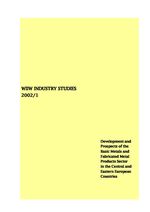Developments and Prospects of the Basic Metals and Fabricated Metal Products Sector in the Central and Eastern European Countries
wiiw Industry Study No. 2002/1, February 2002 plus free access to wiiw Industrial Database
Access to wiiw Industrial Database
In the CEECs, as in most other economies, the metals sector is a key part of manufacturing, highly sensitive to changes in the business cycle. It is considered a capital- (basic metals), labour- (fabricated metal products) and energy-intensive industry, producing a wide range of products (e.g. basic metals, tanks, steam generators, cutlery, tools, light metal packaging, wires etc.). In Central Europe, the sector enjoyed a priority position during communism and has maintained its important role - though declining - in production, employment and foreign trade until the present day. However, its inflated size makes it a 'high burden industry' in need of further restructuring, including cuts in capacities and employment.
The study investigates the development and prospects of the metals sector in the following countries: Bulgaria, the Czech Republic, Hungary, Poland, Romania, Slovakia, Slovenia.
In size, the metals sector is of major importance in the Central and Eastern European countries today, contributing between 8% and 17% of manufacturing output. It has a particularly strong position in Slovakia, Romania, Bulgaria and the Czech Republic, and is relatively smaller in Hungary. When compared with both the countries of the 'EU-North' and the 'EU-South', the CEECs generally show a larger metals sector.
In the first phase of transition, lasting from 1989 to around 1992, a severe transformational recession hit the region, with the output of the metals sector declining even more than the rest of the economy. After 1993, production started to rise in most countries but growth remained weak. This was partly due to a shift of demand towards higher-quality products on the domestic market, increasingly met by imports, to constraints in exports to the EU, and to delayed and complex privatization processes in the steel industry. By 2000, the metals sector had surpassed the 1989 level in Poland only.
As is typical for all CEECs and all sectors of manufacturing, wages, productivity and unit labour costs in the metals sector have generally been much lower than in West European countries, for which we use Austria as a point of reference. During transition, sectoral wages and productivity rose in all CEECs, the productivity increase was however less pronounced than in total manufacturing. This may point to changes in the product mix and in the sectoral structure towards higher-quality, more labour-intensive products. Estimated unit labour costs also rose but still remain at a much lower level than in Austria.
On the EU market, the position of CEECs' metal exports is prominent but stagnating: in 1995 and also 2000, CEEC(7) metal exports had a market share of 15% (all shares without intra-EU trade). This share lay significantly above total manufacturing market shares (9% in 1995 and 11% in 2000). On the Austrian market, CEECs' exports had a decisively larger share, accounting for 38% of Austria's non-EU imports of metal products in 1995, climbing to 50.5% in 2000. The CEECs' position as a major export destination for Austrian metal exports is however becoming smaller (32% of Austria's non-EU exports in 2000). In total, the CEECs registered a trade surplus with Austria.
Future prospects of the CEECs' metals sector are overshadowed by delayed and complex privatization processes of large steel companies in the region and will depend on the success of subsequent restructuring, which is also necessary in light of EU accession. Growth potentials on the domestic market (pent-up demand for infrastructure and construction) as well as on export markets (CEE markets, developing countries, EU Single Market) still exist, but might be challenged by higher-quality products from the West.
Keywords: Basic metals and fabricated metal products, iron and steel industry, manufacturing, transition countries
JEL classification: L6, L61
